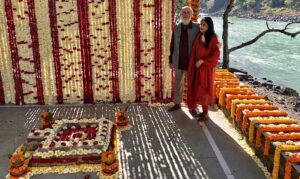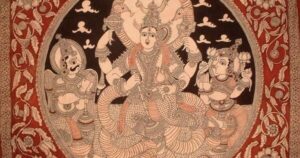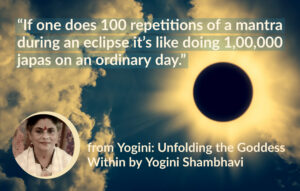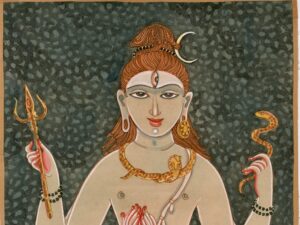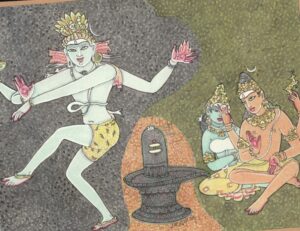Marmas and Pratyahara: Marmas as Control Points
Marmas are prime energy points on the body, in sensitive regions, like joints or around the sensory orifices. They connect to the pranic flows, energy systems and chakras. They have many applications and usages. Here we will consider one of their prime applications in Yoga.
The main aspect of Yoga practice that actively considers the use of marmas is the practice of Pratyahara, which is the fifth branch of Yoga. Pratyahara mediates between the outer factors of Yoga, which include Asana and Pranayama, and the inner factors of Yoga, which mainly consist of meditation. Pratyahara is the door between the outer and inner factors of Yoga that allows us to turn our energy inward.
Pratyahara literally means ‘withdrawal’, like a turtle withdrawing into its shell. It refers to various ‘internalization’ exercises designed to control the senses and motor organs and introvert the mind. Such are closing ones eyes and ears to look and listen within or mauna, the practice of silence and not speaking in order to control the vocal organ. However, there are common and more physical forms of Pratyahara, which are mainly ‘relaxation exercises’; tightening and releasing the energy in various muscles and joints, which affects related marmas. This also clears the energy in the organs and system that the related marmas control.
We can understand the relevance of marmas and Pratyahara when we consider that marmas are ‘control points’, through which Prana and the various organs of the body can be worked on. Each marma point has various organs, systems, senses, nadis and chakras that it rules over. Through working on that particular marma, we can control or affect these factors in various therapeutic manners.
The great yogic text, Vasishta Samhita, contains an important section explaining the use of specific marmas for the practice of Pratyahara. We have included a translation and summary of the material as it is not available in English.
“Great yogis ever praise Pratyahara as concentration (Dharana) in the eighteen marma places of Prana. Drawing the Prana from each of these places is said to be the best form of Pratyahara.” The text then mentions eighteen such marmas and their locations.
Eighteen Yogic Marma Regions and Main Corresponding Marmas
- The toes are the starting point. Kshipra marma.
- The ankles: four and a half finger units from the toes. Gulpha (ankle) marma.
- The middle of the calf: ten finger units from the ankle. Indrabasti marma
- The root of the knee: eleven finger units from the middle of the calf. This marma is not one of the classical 107, but can also be used.
- The center of the knee: two and a half finger units from the root of the knee. Janu marma.
- The middle of the thigh: From the knee to the middle of the thigh is nine finger units. Urvi marma.
- The anus: From the middle of the thigh to the root of the anus is nine finger units. Guda marma.
- The middle of the hip: From the root of the anus to the middle of the hip is two and a half finger units. Kukundara and Nitamba marmas.
- The root of the urethra: From the middle of the hip to the root of the urethra is two and a half finger units. Vitapa marma.
- The navel: From the root of the urethra to the navel is ten and a half finger units. Nabhi (navel) marma.
- The center of the heart: From the navel is the middle of the heart is fourteen finger units. Hridaya (heart) marma.
- The base of the throat: six finger units from the middle of the heart. Nila marma.
- The root of the tongue: From the root of the throat to the root of the tongue is four finger units. Shringataka marma.
- The root of the nose: From the root of the tongue to the root of the nose is four finger units. This marma is not one of the classical 107, but control of it can be related to Phana marma by the nostrils at the base of the nose.
- The center of the eyes: From the root of the nose to the eyes is one-half finger units. Apanga marma.
- The middle of the brows: From there to the middle of the brows is one-half finger unit. Sthapani marma.
- The center of the forehead. From the middle of the brows to the center of the forehead is three finger units. The marma point here is not one of the classical 107 but is still very useful.
- The top of the head: From the middle of the forehead to the top of the head is three finger units. Adhipati marma.
These eighteen marma regions include points for seven chakras (the root of the anus (Muladhara), the root of the urethra (Svadishthana), the navel (Manipura), the heart (Anahata), the root of the throat (Vishuddha), the middle of the brows (Ajna) and the top of the head.
The regions of the eyes, the root of the nose and the root of the tongue, as well as the middle of the brows relate to the third eye or Ajna chakra. Similarly, the point on the forehead relates to the crown chakra. The point at the root of the tongue is an important meditation place and gives control over Soma or amrit.
These marma regions also relate to the fourteen nadis or channels of yogic thought. The root of the anus relates to Alambusha nadi. The root of the urethra relates to Kuhu nadi. The navel relates to Vishvodhara nadi. The heart relates to Varuna nadi. The root of the tongue relates to the Sarasvati nadi. The top of the head relates to the Sushumna nadi. The eyes relate to the Pusha and Gandhari nadis. The marmas along the legs relate to the Hastijihva (right side) and Yashasvati (left-side) nadis.
Marmas, Regions of the Body and the Five Elements
The body can be divided into five regions relative to the five elements. We can treat the elements in the body according to the marmas in the portion that relates to them.
1. MARMAS IN THE REGION FROM THE FEET BELONG TO THE EARTH ELEMENT.
Key marma: Talahridaya on the feet.
2. MARMAS IN THE REGION FROM THE KNEES TO THE ANUS BELONG TO THE WATER ELEMENT.
Key marma: Urvi marma on the middle of the thighs.
3. MARMAS IN THE REGION FROM THE ANUS TO THE HEART BELONG TO THE FIRE ELEMENT.
Key marma: Nabhi (navel) marma on the navel.
4. MARMAS IN THE REGION FROM THE HEART TO THE MIDDLE OF THE EYEBROWS BELONG TO THE AIR ELEMENT.
Key marma: Phana marma on the nostrils.
5. MARMAS IN THE REGION FROM THE MIDDLE OF THE BROWS TO THE TOP OF THE HEAD BELONG TO THE ETHER ELEMENT.
Key marma: Adhipati marma on the head.
Marma Meditation
Below we have presented a form of meditation and Pratyahara using marma points according to this yogic teaching, as Vasishta Samhita states, “One should practice concentration by drawing one’s Prana by the power of attention from each of these marma regions.” To do this practice the following method carefully, using inhalation and exhalation at each marma region, much like flexing and relaxing of the muscles.
1. Direct your attention to your toes. On inhalation, gather your energy there. On exhalation, release it. Feel this region of your body energized, healed and relaxed.
2. Move your attention to your ankles. On inhalation, gather your energy there. On exhalation, release it. Feel this region of your body energized, healed and relaxed.
3. Move your attention to the middle of your calves. On inhalation, gather your energy there. On exhalation, release it. Feel this region of your body energized, healed and relaxed.
4. Move your attention to the base of your knees. On inhalation, gather your energy there. On exhalation, release it. Feel this region of your body energized, healed and relaxed.
5. Move your attention to the middle of your knees. On inhalation, gather your energy there. On exhalation, release it. Feel this region of your body energized, healed and relaxed.
6. Move your energy to the middle of your thighs. On inhalation, gather your energy there. On exhalation, release it. Feel this region of your body energized, healed and relaxed.
7. Move your energy to the root of your anus. On inhalation, gather your energy there. On exhalation, release it. Feel this region of your body energized, healed and relaxed.
8. Move your energy to the middle of your hips. On inhalation, gather your energy there. On exhalation, release it. Feel this region of your body energized, healed and relaxed.
9. Move your energy to the root of your urethra. On inhalation, gather your energy there. On exhalation, release it. Feel this region of your body energized, healed and relaxed.
10. Move your energy to your navel. On inhalation, gather your energy there. On exhalation, release it. Feel this region of your body energized, healed and relaxed.
11. Move your energy to your heart. On inhalation, gather your energy there. On exhalation, release it. Feel this region of your body energized, healed and relaxed.
12. Move your energy to the root of your throat. On inhalation, gather your energy there. On exhalation, release it. Feel this region of your body energized, healed and relaxed.
13. Move your attention to the root of your tongue. On inhalation, gather your energy there. On exhalation, release it. Feel this region of your body energized, healed and relaxed.
14. Move your attention to the root of your nose. On inhalation, gather your energy there. On exhalation, release it. Feel this region of your body energized, healed and relaxed.
15. Move your attention to your eyes. On inhalation, gather your energy there. On exhalation, release it. Feel this region of your body energized, healed and relaxed.
16. Move your attention to the point between your brows. On inhalation, gather your energy there. On exhalation, release it. Feel this region of your body energized, healed and relaxed.
17. Move your attention to the middle of your forehead. On inhalation, gather your energy there. On exhalation, release it. Feel this region of your body energized, healed and relaxed.
18. Move your attention to the top of the head. On inhalation, gather your energy there. On exhalation, release it. Feel this region of your body energized, healed and relaxed.
In this practice one concentrates both mind and Prana in each of these regions starting with the feet. Gather your attention from one marma region to another like climbing a series of steps from the bottom of the body to the top of the body. Finally, you can hold your awareness at the top of the head in the space of the Supreme Self beyond birth and death and all suffering. However, you can also direct your breath and attention to any of these marma sites to heal that area or for specific therapeutic purposes.
Marmas and the Use of Mantra
Mantra is not only used for spiritual purposes but has a wide application for healing purposes. Mantra therapy, Mantra Chikitsa, is widely used in all aspects of Ayurveda. Mantras have a special application to energize and protect marma points. Mantras can create a protective covering or armor (kavacha) at a psychic or pranic level. They also facilitate the flow of Prana through the marma region which can be directed by our energy of attention. Many mantras can be used for this purpose. For the sake of brevity and simplicity we will only mention a few. The Mantra Purusha, which correlates the different root sounds of the Sanskrit alphabet to the various parts of the body, can also be used for this purpose.
Important Bija (Seed) Mantras and Usage With Marmas
- The mantra HUM (pronounced ‘hoom’) is Varma bija or the seed sound of protection, having a fiery nature. It can be used specifically to protect marma and varma points and is probably the most important mantra in this regard. It can be repeated relative to any marma that one wants to protect from injury or debility. This mantra can be used along with the marma meditation practice outlined above to create a protection of mantra (mantra-varma) around the physical body and the aura. Visualize this mantra as creating a deep blue protective force that can ward away all negativity, disease or debility.
Chanted with a shorter u-sound, as in the word ‘put’, HUM has a more fiery energy for purposes of warming the marmas and increasing Agni or fire at their locations. - The mantra OM is Prana bija or the seed sound of energy and vitality. It can be repeated relative to any marma that one wants opened, cleared and released. It carries the energy and immortal force of the higher Self (Atman).
- The mantra AIM (pronounced ‘aym’) is Guru bija the seed sound of speech, guidance and concentration. It can be used for directing mental energy and healing intentions to any marma point. It holds the Sarasvati energy, the energy of wisdom and creativity.
- The mantra KRIM (pronounced ‘kreem’) is the seed sound of Kriya shakti or the power of action and represents electrical force. It can be used to stimulate and energize any marma with pranic force. It holds the Kali energy, the energy of transformation, internalization and spiritual awakening.
- The mantra SHRIM (pronounced ‘shreem’) is the seed sound of well-being and projects a nutritive lunar energy. It can be used to heal or soothe any marma region, particularly from conditions of weakness. It holds the Lakshmi energy or the positive force of health, well-being and prosperity.
- The mantra HRIM (pronounced ‘hreem’) is the seed sound of the heart, space and Prana and projects a solar force. It can be used to open, energize and heal any marma. It holds the Goddess energy in general as a force of health, vitality and enlightenment.
- The mantra KLIM (pronounced ‘kleem’) is the power of attraction or magnetic energy. It can be used to increase Kapha or Ojas energy at any marma.
You should recite these mantras a minimum of 108 times (or multiples thereof) for one month (preferably between two new moons) in order to fully energize any marma. It is best to meditate upon the marma you intend to energize and repeat the mantra along with the breath, energizing the marma on inhalation and releasing it on exhalation.
Mantras for the Elements and the Chakras
The seed mantras of the elements can also be used at the marma points that connect to the chakras, like the mantra YAM for the region of the heart.
| Earth | LAM (pronounced lum as in ‘lump’) |
| Water | VAM (pronounced vum) |
| Fire | RAM (pronounced rum as in ‘rump’, with the r-sound rolled) |
| Air | YAM (pronounced yum) |
| Ether | HAM (pronounced hum as in ‘hump) |
Mantra Marma Meditation
One can also use mantras relative to the eighteen marma regions mentioned above. In this regard, use the mantra OM on inhalation to gather energy in the marma region, and use the mantra HUM on exhalation to protect and fortify the marma. One can visualize OM as creating a golden light to energize the marma and HUM creating a dark blue light to protect it.

